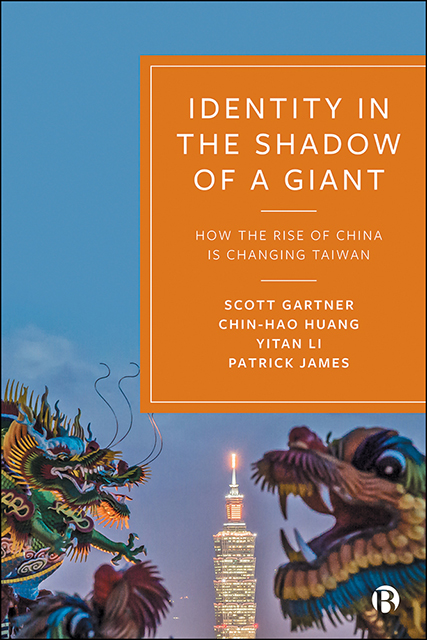Book contents
- Frontmatter
- Dedication
- Contents
- List of Figures and Tables
- About the Authors
- Acknowledgements
- Preface
- 1 Identity in the Shadow of a Giant: How the Rise of China Is Changing Taiwan
- 2 Taiwan in Historical Perspective
- 3 The Problématique of Taiwanese Identity
- 4 Theorizing about Identity, Change in Capabilities and Dyadic Relations: An Approach Based on Analytic Eclecticism and Systemism
- 5 Elite Reflections
- 6 Popular Reflections (Survey I)
- 7 Factors Influencing Identifying Only as Taiwanese: A Layered Empirical Approach (Survey II)
- 8 A New Vision of Taiwanese Identity, the Rise of China, Cross-Strait Relations and the United States in Northeast Asia
- Appendix A Research Interview Questions, September–October 2015
- Appendix B Taiwanese Identity and the Rise of China: Survey Questions, 27 October 2015
- Appendix C Taiwan National Security Survey by Emerson Niou
- References
- Index
5 - Elite Reflections
Published online by Cambridge University Press: 15 April 2023
- Frontmatter
- Dedication
- Contents
- List of Figures and Tables
- About the Authors
- Acknowledgements
- Preface
- 1 Identity in the Shadow of a Giant: How the Rise of China Is Changing Taiwan
- 2 Taiwan in Historical Perspective
- 3 The Problématique of Taiwanese Identity
- 4 Theorizing about Identity, Change in Capabilities and Dyadic Relations: An Approach Based on Analytic Eclecticism and Systemism
- 5 Elite Reflections
- 6 Popular Reflections (Survey I)
- 7 Factors Influencing Identifying Only as Taiwanese: A Layered Empirical Approach (Survey II)
- 8 A New Vision of Taiwanese Identity, the Rise of China, Cross-Strait Relations and the United States in Northeast Asia
- Appendix A Research Interview Questions, September–October 2015
- Appendix B Taiwanese Identity and the Rise of China: Survey Questions, 27 October 2015
- Appendix C Taiwan National Security Survey by Emerson Niou
- References
- Index
Summary
Overview
This chapter conveys and assesses elite reflections obtained from multiple waves of research interviews conducted in Taiwan. Material from those dialogues will facilitate our reassessment of the conventional wisdom identified in Chapter 4 and reflect support for the construction of our diagrammatic approach. Recall the systemist Figure 4.2, which conveyed cause and effect for the rise of China, Taiwanese identity, cross-Strait relations and the role of the US as gleaned from the academic literature. The depth from descriptive analysis of interviews in this chapter is intended to complement the breadth obtained from survey research assessed in Chapters 6–7. All of this will be compared in Chapter 8 with the graphic story of cause and effect told by the academic literature and encapsulated in Figure 4.2 from Chapter 4. Analysis will culminate in an elaborated systemist visualization that builds upon Figure 4.2 through incorporation of what has been learned in Chapters 5–7.
Content from the interviews is assembled into the following categories: meaning of identity; the 1992 Consensus and identity; deepening business, trade and economic ties; Sunflower Movement of 2014; textbook controversy and colonial legacy; China's rise, identity and the US role; and Tsai's presidency and cross-Strait relations. This is an intentionally inductive approach that covers sets of issues as these combine together naturally through the interviews. Moreover, this comprehensive approach is in line with principles from analytic eclecticism and systemism that underlie the project as a whole.
Work continues in four additional sections. The second section introduces the interviews in terms of time, place and representativeness. The third section contains the content of the interviews organized into the categories enumerated in the previous paragraph. Analysis and synthesis of that material, notably in terms of (dis)agreement among interviewees, takes place in the fourth section. The fifth and final section sums up the chapter's contributions.
Characteristics of the interviews
Chin-Hao Huang and Patrick James carried out the bulk of the research interviews in Taipei during September and October of 2015, respectively. Given the proximity of those visits to the presidential election of 16 January 2016, political issues held an even greater importance than under normal conditions for both elite and public. On the one hand, this closeness to the election might have the disadvantage of evoking more emotional responses than otherwise would be expected.
- Type
- Chapter
- Information
- Identity in the Shadow of a GiantHow the Rise of China is Changing Taiwan, pp. 91 - 124Publisher: Bristol University PressPrint publication year: 2021

